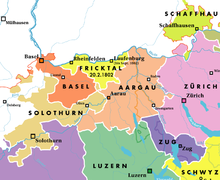
Aargau, more formally the Canton of Aargau, is one of the 26 cantons forming the Swiss Confederation. It is composed of eleven districts and its capital is Aarau.

Oberhof is a municipality in the district of Laufenburg in the canton of Aargau in Switzerland.

The Helvetic Republic was a sister republic of France that existed between 1798 and 1803, during the French Revolutionary Wars. It was created following the French invasion and the consequent dissolution of the Old Swiss Confederacy, marking the end of the ancien régime in Switzerland. Throughout its existence, the republic incorporated most of the territory of modern Switzerland, excluding the cantons of Geneva and Neuchâtel and the old Prince-Bishopric of Basel.
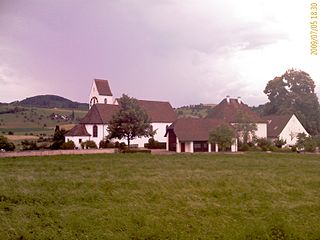
Magden is a municipality in the district of Rheinfelden in the canton of Aargau in Switzerland.

The Canton of Baden was a canton of the Helvetic Republic. Its capital was the town of Baden.

Further Austria, Outer Austria or Anterior Austria was the collective name for the early possessions of the House of Habsburg in the former Swabian stem duchy of south-western Germany, including territories in the Alsace region west of the Rhine and in Vorarlberg.
Rheinfelden is a municipality in the canton of Aargau in Switzerland, seat of the district of Rheinfelden. It is located 15 kilometres east of Basel. The name means the fields of the Rhine, as the town is located on the High Rhine. It is home to Feldschlösschen, the most popular beer in Switzerland. The city is across the river from Rheinfelden in Baden-Württemberg; the two cities were joined until Napoleon Bonaparte fixed the Germany–Switzerland border on the Rhine in 1802 and are still socially and economically tied.

Zuzgen is a municipality in the Rheinfelden District of canton Aargau in Switzerland. It is located in the West of the Fricktal region, around three kilometers southwest of the border with Germany, and has a border with Canton Basel-Landschaft.
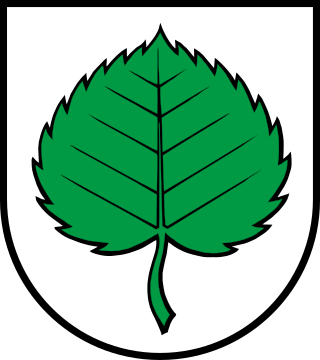
The Fricktal is a region on Northwestern Switzerland, comprising the Laufenburg and Rheinfelden districts of the Swiss canton of Aargau. The region was known as Frickgau in the medieval period, ultimately from a Late Latin [regio] ferraricia, in reference to the iron mine located here in the Roman era, also transferred to the village of Frick as the main settlement.

The Act of Mediation was issued by Napoleon Bonaparte, First Consul of the French Republic on 19 February 1803 to abolish the Helvetic Republic, which had existed since the invasion of Switzerland by French troops in 1798, and replace it with the Swiss Confederation. After the withdrawal of French troops in July 1802, the Republic collapsed. The Act of Mediation was Napoleon's attempt at a compromise between the Ancien Régime and a republic. This intermediary stage of Swiss history lasted until the Restoration of 1815. The Act also destroyed the statehood of Tarasp and gave it to Graubunden.

Laufenburg is a municipality in the Swiss canton of Aargau. It is the seat of the district of the same name. On 1 January 2010 the municipality Sulz merged into Laufenburg.

High Rhine is the name of the part of the Rhine between Lake Constance and the city of Basel, flowing in a general east-to-west direction and forming mostly the Germany–Switzerland border. It is the first of four named sections of the Rhine between Lake Constance and the river delta at the North Sea.
Gansingen is a municipality in the district of Laufenburg in the canton of Aargau in Switzerland.

Herznach is a former municipality in the district of Laufenburg in the canton of Aargau in Switzerland. On 1 January 2023 the former municipalities of Herznach and Ueken merged to form the new municipality of Herznach-Ueken.

Münchwilen is a municipality in the district of Laufenburg in the canton of Aargau in Switzerland.
Oeschgen is a municipality in the district of Laufenburg in the canton of Aargau in Switzerland.

Hellikon is a municipality in the Rheinfelden district of canton Aargau in Switzerland. It is located in the West of the Fricktal region, around four kilometers Southwest of the border with Germany and has a border with Canton Basel-Landschaft.
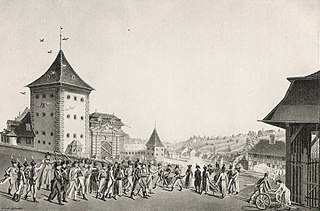
The Stecklikrieg was a civil war in Switzerland in 1802 that resulted in the collapse of the Helvetic Republic, the renewed French occupation of Switzerland and ultimately the Act of Mediation dictated by Napoleon Bonaparte on 19 February 1803. The conflict itself was between insurgents, mostly drawn from the rural population, and the official forces of the Helvetic Republic. The term Stäckli, or "wooden club," from which the conflict draws its name, refers to the improvised weaponry of the insurgents.

The Möhlintal is a 10-kilometre long valley running between Möhlin and Wegenstetten in the Rheinfelden district of Canton Aargau, Switzerland. The five municipalities in the valley have a total population of around 14,000 people.
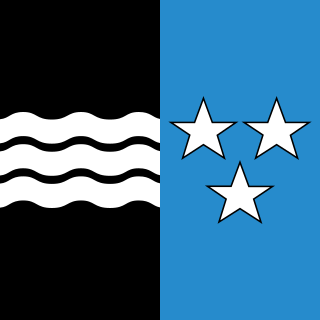
The History of the Canton of Aargau is dedicated to Aargau in Switzerland, founded in 1803, and its various preceding territories.
